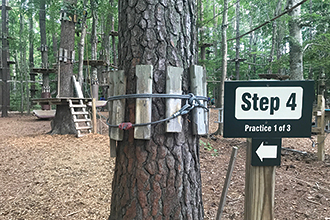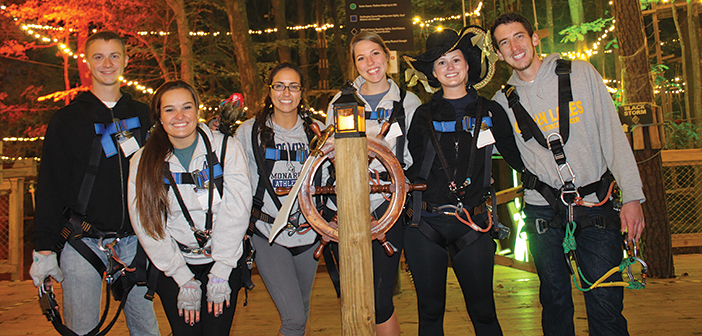The ultimate compliment for any business is a returning customer. It’s a clear sign the business is doing something right. But aerial adventure operations aren’t the same as, say, someone’s favorite ice cream shop. There are special challenges to earning repeat business in an industry that provides, for many consumers, a bucket-list experience, and several creative solutions.

Naturalist tours augment the aerial adventure at ZipZone, Ohio.
Depending on where an aerial adventure operation is located, repeat business may be more vital (and attainable) for some than it is for others. Case in point: ZipZone Outdoor Adventures in Ohio. “We are not in a tourist area, so we are quite different from a lot of other tours and adventure parks,” says owner Lori Pingle. “We are located just outside the city of Columbus [Ohio] in a beautiful natural area right off of a major road in an urban/suburban sprawl. We thrive on repeat customers” and those who return with friends. A zip tour located in a tourist destination that caters primarily to non-local guests may have less reliance on repeat business, but it still wants people to come back while on vacation in future years.
So earning guests’ loyalty should be a part of everyone’s strategy, and there are several ways to go about it. Some of the following points apply to successful operations generally, while others specifically address growing repeat business. Add them all up, and you should start seeing familiar faces at your park more often—and hearing the register ring more frequently.
The Product
Quality matters. “Many factors go into providing an exceptional customer experience that leads to return visits, but the first and most important factor is having a product they enjoy—fun courses to climb,” says Outdoor Ventures president Bahman Azarm. “Neither the most beautiful location nor the best customer service can replace it.”
Choice matters, too. Practice makes perfect, but variety is the spice of life. For this reason, adventure parks with multiple activities are ideally suited to attract repeat customers. However, an aerial course with different routes and varying levels of difficulty or thrill will keep them coming back, too.

Easy navigation helps encourage familiarity, as Outdoor Ventures has seen.
Azarm says Outdoor Ventures’ parks operate more like a ski area, with different trails to choose, than a golf course, which has a single course to play. This design allows guests to choose their difficulty level, with most opting for the easy to moderate courses. “This has the added advantage of giving the customer something to look forward to, and is a lure to come back for a future visit to climb a more difficult level,” says Azarm.
Challenge Towers president Ken Jacquot agrees. At Jacquot’s High Gravity Adventures, a zip line and aerial adventure park in Blowing Rock, N.C., developing loyal costumers is a top priority. To that end, the park provides an opportunity for guests to set goals that, in turn, encourage return visits.

Friendly, even entertaining, guest service—like that delivered by High Gravity Adventures—encourages visitors to come back time and again.
“Have options for growth on your course,” he says. “When someone comes in terrified, but they end up conquering the first level of the course, they are super proud of themselves, and we tell them how proud of them we are! Then we encourage them to take it one step at a time. Next time you come back, maybe you’ll be ready to try the second level! And maybe one day the third level!”
And that leads us to the next element of attracting return visitors: guest service.
Guest Service
Naturally, outstanding guest service is a “must have” in order to be a successful business, not to mention garnering repeat visitors. It’s worth including here, nonetheless.
Consider a restaurant that has great food and a convenient location—but the wait staff are a bunch of jerks, and the food takes forever to arrive at your table. There’s another restaurant nearby with different, but equally great food that shows up at your table quickly, delivered by very friendly and attentive staff. Which one are you more likely to patronize again? A rhetorical question, of course.
In earning the trust of guests and making them feel comfortable enough to return, your staff must provide “exceptional, not just acceptable customer service, and exceed guest expectations on a consistent basis,” says Jacquot. Part of this, he says, is constant guest interaction: check in with them, ask what they’re favorite element is, offer to help when they are struggling. All that humanizes the experience.
But as the saying goes, you can’t please everyone. Jacquot recommends using negative feedback, whether that occurs in person or is found online, as an opportunity to improve. “In certain situations, we’ll even implement changes and then invite the guest to come back so they can see how they have helped us learn and grow,” he says. High Gravity staff will send a disgruntled customer a free ticket or two in the mail with a “thank you note for helping us improve.”
Azarm thinks it’s important to boil it down to the basics. “Eliminate or change the things that hinder customer enjoyment,” he says. “We like to think about a customer’s experience from the time they arrive and park their car to the time they leave.” A simple sign, which reads “Step 1” directs them to registration and ticketing, “Step 2” directs them to the briefing area, and so on. Make it simple, and people are more likely to come back. A confusing experience is frustrating and discourages future visits.
Exemplary guest service reaches beyond the boundaries of the park, though, and extends to how you communicate with visitors who have climbed or zipped with you before. “We will offer discounts and deals and only send them out to our email list to encourage people to be loyal fans,” says Pingle. This imparts a sense of exclusivity and favored treatment, which often goes a long way with guests.
According to Jacquot, frequent communication is key to remaining front of mind. “Give people new and exciting things to look forward to the next time they return. Stay relevant. Keep guests updated with changes via email, and post often on social media,” he says.
Events
A cool event at your park can yield many benefits. It can introduce new guests to the experience you offer, but it can also mix things up for guests who frequent the park.
“We have special events throughout the year to create more interest and to give people something else to try,” says Pingle. “Our Full Moon tours and Freaky Flights are very popular. We have also had birding events, and nature tours with a naturalist from the metro parks.”
Outdoor Ventures employs a similar strategy. “A tempting event with a fun theme adds variety to the experience for repeat climbers,” says Azarm. “The next best thing to adding new courses is adding new flavor to old courses. It’s a change of pace for everyone, without costly course redesign or construction.”
Birthday parties can make inroads with a range of demographics. “This gets a variety of youngsters to come out, and hopefully some will beg their parents to come back another time,” says Pingle. To coax those parents into returning, “We give each guest a party favor that includes a coupon for a free photo and a coupon to come back and zip,” she says. “The free photo gets the parents online to look at it after they get home, and they see what fun their kids had!”
Products
“Do you have customers asking to buy a season pass at your aerial park?” asks Azarm. “If you do, it’s a clear sign that you have a fun and exciting product that customers want to come back to repeatedly.”
Jacquot offers a list of what will help make your season pass products a success:
• Offer a season pass option for unlimited check-ins during the season.
• When a season passholder brings a friend, the friend gets a discount on admission.
• Season passes cover entry into special events, not just regular days.
• Offer an upgrade option: Give guests a chance to try your course out and decide if they like it, then apply the cost of their ticket to a season pass.
• Remember season passholders’ names. Welcome them back. Get to know them. Treat them like family.
Tweak what you offer for a season pass, and decide if you’re going to provide multiple options (four-visit pass, 10-visit pass, shoulder season pass, unlimited pass) at different price tiers. It all depends on your business levels, capacity, and location. Regardless, a season pass is sure way to develop loyal customers.

ZipZone’s frequent zipper card tells guests they should, of course, return.
Another option is to reward your most loyal customers. That is exactly what Pingle does at ZipZone with a Frequent Zipper Card. “Every time someone comes out to zip, we punch a hole in the card,” says Pingle. After three visits, the cardholder gets a shirt or hat; after five visits, a voucher for a free tour; and after 10 visits, a free tour for two.
“Not only does this reward people for coming back, it also puts the idea in people’s minds that they should come back—that this is not a one-and-done activity,” she says. There’s value in providing guests something tangible as a reminder of the experience they had, and that there’s incentive to return.
Off-Season Loyalty
Speaking of products, both Jacquot and Pingle engage in selling products to current and potential repeat customers during the off season. It’s a smart way to keep their parks front of mind, even if the parks are closed. And by offering good deals, customers feel like they’re getting value for their money, which leaves a good taste in any consumer’s mouth.
Jacquot suggests having a “pre-season sale” after the current season ends. “Directly reach out to previous passholders to entice them to re-purchase,” he says. In other words, strike while the iron is hot. Lock them in, and give them something to look forward to when the doors re-open in spring.
Pingle takes advantage of the holiday shopping extravaganza. “Starting on Black Friday we offer discounted gift cards,” she says. “We advertise through our email list and social media. We have found most of the people who buy them have been here before. It is a great way to spread the word, earn some loyalty, and also bring in some revenue when we’re closed.” Those are multiple benefits for what is a pretty simple plan.
For most parks, building a base of repeat customers takes time to develop—but it’s worth it, and can have huge payoff.
Focus on a few key points, Azarm says: “Simply put: 1) give customers a fun climbing experience; 2) take care of them while they are there; and 3) give them the potential to challenge themselves in variety of ways, so a visit to your park always holds something new and fresh. Then they will have good reason to ask whether you sell a season pass.”



